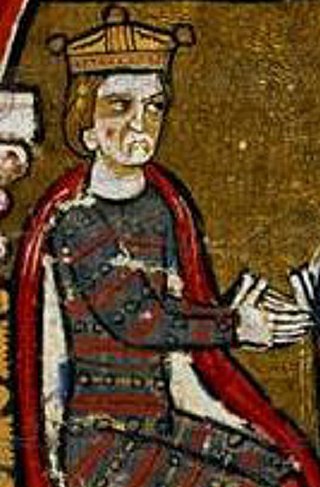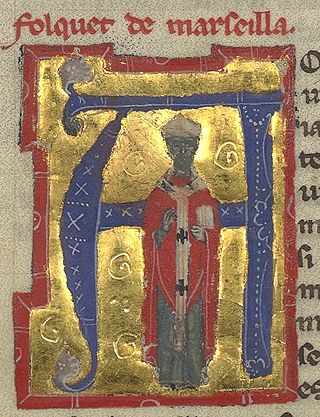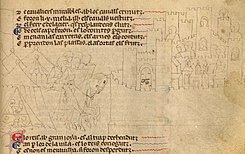Catharism was a Christian dualist or Gnostic movement between the 12th and 14th centuries which thrived in Southern Europe, particularly in northern Italy and southern France. Followers were described as Cathars and referred to themselves as Good Christians; in modern times, they are mainly remembered for a prolonged period of religious persecution by the Catholic Church, which did not recognize their unorthodox Christianity.

Peter II the Catholic was the King of Aragon and Count of Barcelona from 1196 to 1213.

Louis VIII, nicknamed The Lion, was King of France from 1223 to 1226. As prince, he invaded England on 21 May 1216 and was excommunicated by a papal legate on 29 May 1216. On 2 June 1216, Louis was proclaimed "King of England" by rebellious barons in London, though never crowned. He soon seized half the English kingdom but was eventually defeated by the English and after the Treaty of Lambeth, was paid 10,000 marks, pledged never to invade England again, and was absolved of his excommunication.

The Albigensian Crusade or the Cathar Crusade was a military and ideological campaign initiated by Pope Innocent III to eliminate Catharism in Languedoc, southern France. The Crusade was prosecuted primarily by the French crown and promptly took on a political aspect. It resulted in the significant reduction of practicing Cathars and a realignment of the County of Toulouse with the French crown. The distinct regional culture of Languedoc was also diminished.

Albi is a commune in southern France. It is the prefecture of the Tarn department, on the river Tarn, 85 km northeast of Toulouse. Its inhabitants are called Albigensians. It is the seat of the Archbishop of Albi.

Simon de Montfort, 5th Earl of Leicester, known as Simon IVde Montfort and as Simon de Montfort the Elder, was a French nobleman and knight of the early 13th century. He is widely regarded as one of the great military commanders of the Middle Ages. He took part in the Fourth Crusade and was one of the prominent figures of the Albigensian Crusade. Montfort is mostly noted for his campaigns in the latter, notably for his triumph at Muret. He died at the Siege of Toulouse in 1218. He was lord of Montfort-l'Amaury from 1188 to his death and Earl of Leicester in England from 1204. He was also Viscount of Albi, Béziers and Carcassonne from 1213, as well as Count of Toulouse from 1215.

The Château de Montségur is a former fortress near Montségur, a commune in the Ariège department in southern France. Its ruins are the site of a razed stronghold of the Cathars. The present fortress on the site, though described as one of the "Cathar castles," is actually of a later period. It has been listed as a monument historique by the French Ministry of Culture since 1862.

Raymond VI was Count of Toulouse and Marquis of Provence from 1194 to 1222. He was also Count of Melgueil from 1173 to 1190.

Bruniquel is a commune in the Tarn-et-Garonne department in the Occitanie region in southern France.
William of Tudela was the author of the first part of the Canso de la Crozada or Song of the Albigensian Crusade, an epic poem in Old Occitan giving a contemporary account of the crusade against the Cathars.

Folquet de Marselha, alternatively Folquet de Marseille, Foulques de Toulouse, Fulk of Toulouse came from a Genoese merchant family who lived in Marseille. He is known as a trobadour, and then as a fiercely anti-Cathar bishop of Toulouse.

Cathar castles are a group of medieval castles located in the Languedoc region. Some had a Cathar connection in that they offered refuge to dispossessed Cathars in the thirteenth century. Many of these sites were replaced by new castles built by the victorious French Crusaders and the term Cathar castle is also applied to these fortifications despite their having no connection with Cathars. The fate of many Cathar castles, at least for the early part of the Crusade, is outlined in the contemporary Occitan "Chanson de la Croisade", translated into English as the "Song of the Cathar Wars ".

The Canso d'Antioca is a late twelfth-century Occitan epic poem in the form of a chanson de geste describing the First Crusade up to the Siege of Antioch (1098). It survives only in a single manuscript fragment of 707 alexandrines, now preserved in Madrid.

Gui de Cavalhon, Cavaillo, or Gavaillo was a Provençal nobleman: a diplomat, warrior, and man of letters. He was probably also the Guionet who composed tensos and partimens with Cadenet, Raimbaut de Vaqueiras, Mainart Ros, Pomairol, and a certain Guillem.
Guy de Montfort was the younger son of Simon de Montfort and Amicia, sister of Robert FitzPernel, Earl of Leicester.
A Crusade song is any vernacular lyric poem about the Crusades. Crusade songs were popular in the High Middle Ages: 106 survive in Occitan, forty in Old French, thirty in Middle High German, two in Italian, and one in Old Castilian. The study of the Crusade song, which may be considered a genre of its own, was pioneered by Kurt Lewent. He provided a classification of Crusade songs and distinguished between songs which merely mentioned, in some form, a Crusade from songs which were "Crusade songs". Since Lewent, scholars have added several classifications and definitions of Crusade songs. Scholars have argued for three different classifications of Crusade songs which include songs of exhortation, love songs, and songs which criticize the Crusading movement.

The siege of Minerve was a military engagement which took place in June and July 1210 during the Albigensian Crusade in the town of Minerve in southern France. It was undertaken by the Catholic Crusaders against the Cathars in southern France, who were regarded as a heretical sect. The Crusaders, led by French nobleman Simon de Montfort, besieged and captured the town. The Crusaders allowed the soldiers defending the town, Catholics, and any Cathars who had not yet reached the status of perfect to go free. Three Cathar perfects who repented were pardoned, but 140 others who refused to do so were burnt at the stake.
Guy was the sixth Cistercian abbot of Vaux-de-Cernay from 1181 until 1210 and then the bishop of Carcassonne from 1212 until his death. The crusades dominated his life. He was a preacher, organizer and spiritual leader of the Fourth Crusade, which he abandoned after it turned against fellow Catholics, and also of the Albigensian Crusade against heretics.
Michel Roquebert was a French writer and historian.
Maurice Magre was a French writer, poet, and playwright.













